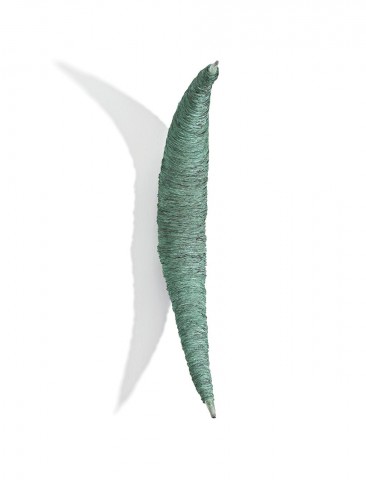BLUE MOON, 1990
BRONWYN OLIVER
copper and lead
60.0 cm height
Christine Abrahams Gallery, Melbourne
Private collection, Sydney
Bronwyn Oliver, Christine Abrahams Gallery, Melbourne, 9 September – 8 October 1992
The Sculpture of Bronwyn Oliver, TarraWarra Museum of Art, Victoria, 19 November 2016 – 5 February 2017
Fink, H., Bronwyn Oliver, Strange Things, Piper Press, Sydney, 2017, pp. 72 (illus.), 77 (illus. with the artist), 219
Encrusted with a crystalline patina, Blue Moon, 1990 has the aura of an ancient relic retrieved from the watery depths of the ocean floor. Was Oliver playing on the enduring symbiotic relationship between the moon and the sea, or perhaps there is something futuristic and sinister in the tightly wound copper coils and protruding claws of this crescent? The instinct to grapple with such poetic associations is human, and the result of a carefully laid trap that Bronwyn Oliver, as Ariadne, has woven for her audience.
Blue Moon was the final work Oliver completed during her 6-month Power Bequest Studio residency in Paris, at the Cité Internationale des Arts, from November 1989 to June 1990.1 Bearing the patinated hallmarks of her early explorations into woven wired forms, Blue Moon absorbs and emanates energy. Its forms are twisted, swaddled and moulded by Oliver’s obsessive creative energy, and in turn, its ancient form radiates an ethereal and cosmic aura. There is a sublime contradiction in the shadows that are cast from this construction. The light that the moon radiates is not its own, but merely a reflection of the sun’s energy. However, this moon casts only a shadow. Furthermore, a blue moon is the second full moon in a calendar month, yet this sculpture has a crescent shaped form more like a waxing or waning gibbous moon. In using the word ‘blue’ in the title, the sculptor instead draws attention to the work’s patina, while eliciting notions of rarity and preciousness in the viewer’s mind.
This sculpture, like a great number of Oliver’s works, conveys the idea of metamorphosis. With titles such as Comet, Hatchery, Husk and Survivor, the sculptures from this period adopted forms that expressed these liminal states of being, often echoing protective shells and cocoons. Many of these woven creations were constructed around a central wooden or paper armature that would later be burnt away. Copper wire, when wound in coils like the ones that bind the structure of this irregular crescent, is also used to conduct electricity, endowing Blue Moon with an energy that is undeniably modern.
Whilst in Paris, Oliver was contacted by Graeme Sturgeon, an authority on Australian sculpture, who was in the process of compiling a survey of contemporary Australian sculptors and their work. Oliver’s answers to his questions provide vital insight into her mindset and ambitions at this point in her career. In describing her most successful works, she remarked that with a perfect combination of concept, medium and execution, the sculpture would ’sing’, and using a ’poetry of association’, would transcend conventional markers of time and space.2
The transcendental and universal quality of Oliver’s sculptures relies on the enduring power of her organic shapes. While Oliver denied any clear naturalistic inspiration in her work, her manipulation of materials inevitably brought her to the circular, spiral and crescent forms that are so prevalent in the natural world. The impetus that drove her work was ontological, coming directly from the materials themselves and the structures they could come to embody. However, Oliver was offended by critics’ tendency to associate her work with women’s craft,3 hoping instead that her work sat somewhere between the organic and the artisanal. Despite her unwavering commitment and dedication to her sculptures, Oliver’s forms are imperfect, bearing the traces of her creative effort. But as Oliver conceded, ’evidence of the struggle – that’s what makes it human’.4
1. Fink, H., Bronwyn Oliver – Strange Things, Paper Press, Sydney, 2017, p. 80
2. Sturgeon, G., Contemporary Australian Sculpture, Craftsman House, Sydney, 1991, p. 73 – 74
3. The artist cited in Fink, H., op. cit., p. 72 ‘I feel that references to the craft aspect of my work trivialises my intentions. The craft of making is only important in the service of an idea’.
4. op. cit., p. 64
LUCIE REEVES-SMITH
